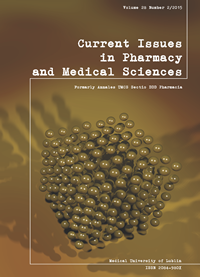Effect of compression pressure on mechanical and release properties of tramadol matrix tablets
DOI:
https://doi.org/10.1515/cipms-2015-0057Keywords:
compression pressure, matrix tablet, mechanical properties, release propertiesAbstract
Drug delivery to the proper site of action in the body is greatly influenced by the excipients used and some processing variables such as changes in compression force.The aim of this investigation was to study the influence of changes in compression forces during tablet manufacturing on the mechanical and release properties of Tramadol matrix tablet. Hardness and friability were used as assessment parameters for mechanical properties while release properties were analysed using dissolution test. Data were analysed using One-way ANOVA at p < 0.05.Tablet hardness and friability were typically compression pressure-dependent with a significant difference in tablet hardness and friability with increase in compression pressure (p < 0.001).Drug release was best expressed by Korsmeyer-Peppas equation as the plots showed high linearity (r2) of 0.998 and 0.988 for formulations containing Xanthan gum and Sodium carboxymethylcellulose, respectively. Drug release from formulations containing Xanthan gum was mainly by diffusion while a combination of diffusion and chain relaxation was the mechanism of drug release from formulation containing Sodium Carboxymethylcellulose.The release properties of tramadol matrix tablet were not significantly influenced by compression pressure but rather by the polymer and the material properties of the drug.
References
1. Adeleye O.A., Femi-Oyewo M.N., Odeniyi M.A.: The effect of processing variables on the mechanical and release properties of tramadol matrix tablets incorporating Cissus populnea gum as controlled release excipients. Poly. Med., 44(4), 209, 2014.
2. Adeleye A.O., Odeniyi M.A., Jaiyeoba K.T.: The influence of cissus gum on the mechanical and release properties of paracetamol tablets - a factorial analysis. J. Basic and Appl. Pharm. Sci., 31(2), 131, 2010.
3. Adeleye A.O., Odeniyi M.A., Jaiyeoba K. T.: Evaluation of cissus gum as binder in a paracetamol tablet formulation. Farmacia, 59(1), 85, 2011.
4. Banker G.S., Anderson N.R. (1986). The theory and practice of Industrial Pharmacy. Lachman L., Liebeman H. A., Kanig J. L. (editors), 2nd edition. Philadelphia: Lea and Febger; p. 293.
5. Costa P.J., Lobo M.S.: Modeling and comparison of dissolution profiles. Eur. J. Pharm. Sci., 13, 123, 2001. [CrossRef]
6. Delalonde M., Ruiz T.: Dissolution of pharmaceutical tablets: the influence of penetration and drainage of interstitial fluids. Chem. Eng. Process, 47, 370, 2008. [Web of Science]
7. El-Bagory I. et al.: Formulation and in vitro evaluation of theophylline matrix tablets prepared by direct compression: Effect of polymer blends. Saudi Pharm. J., 20, 229-238, 2012.
8. Femi-Oyewo M.N., Aremu O.I., Kehinde O.J.: Evaluation of Beilschmiedia seed gum as a tablet binder. East and Central Afr. J. Pharm. Sci., 12(2), 15, 2009.
9. Garekani H.A. et al.: Effect of compression force, compression speed and particle size on the compression properties of paracetamol. Drug Dev. Ind. Pharm., 27, 935-42, 2001. [PubMed] [CrossRef]
10. Haresh T.M., Bhumin P. and Nehal J.S.: Development of pH -independent matrix type sustained release drug delivery system of propranolol hydrochloride. J. Appl. Pharm. Sci., 1(3), 83-92, 2011.
11. Higuchi T.: Mechanism of sustained - action medication: Theoretical analysis of rate of release of solid drugs dispersed in solid matrices. J Pharm. Sci., 521, 145, 1963.
12. Ibrahim H., Rai P.P., Bangudu A. B.: Evaluation of mucilage from the stem bark of Cissus populnea. Afri. J. of Pharm. Sci., 22(1), 35, 1991.
13. Johan V.E.: Tablet compression: Improving Tablet Quality with Compression to Equal Force Technology. Supplement to pharmaceutical technology, the industry’s authoritative source. An advanced star publication. Pharm. Tech., 1, 2008.
14. Kalu V.D., Odeniyi M.A., Jaiyeoba K.T.: Matrix properties of a new plant gum in controlled drug delivery. Arch. Pharm. Res., 30(7), 884, 2005. [CrossRef]
15. Korsmeyer R.W., Gurny R., Peppas N. A.: Mechanisms of solute release from porous hydrophilic polymers. Int. J. Pharm., 15, 25, 1983. [CrossRef]
16. Lobman K., et al.: The influence of pressure on the intrinsic dissolution rate of amorphous indomethacin. Pharmaceutics, 6, 481, 2014. [CrossRef]
17. Lunio R. et al.: Compressibility of gastroretentive pellets coated with Eudragit NE using a single-stroke and a rotary tablet press. Pharm. Dev. Technol., 13(4), 323-31, 2008. [Web of Science] [CrossRef]
18. Marais A.F. et al: Effect of compression force, humidity and disintegrant concentration on the disintegration and dissolution of directly compressed furosemide tablets using croscarmellose sodium as disintegrant. Trop. J. Pharm. Res., 2(1), 125-135, 2003.
19. Nanjwande B.K.: Effect of pressure on dissolution and solid state characterization of cefuroxime axetil. J. Anal. Bioana. Tech., 1(3), 112, 2010.
20. Narang A.S. et al.: Effect of force feeder on tablet strength during compression. Int. J. Pharm., 401(1-2), 7-15, 2010. [Web of Science]
21. Odeku O.A., Itiola O. A.: Evaluation of the effect of khaya gum on the mechanicaland release properties of paracetamol tablets. Drug Dev. and Ind. Pharm., 29(3), 311, 2003. [CrossRef]
22. Perez-Marcos B. et al.: Mechanical and drug-release properties of atenolol-carbomer hydrophilic matrix tablets. J. Control Rel., 17, 267-276, 1991.
23. Ritschel W.A., Bauer-Brandl A. (2002). Die Tablette. Canter Verlag, Aulendorf (editors), 2nd Edition. p. 518
24. Rubinstein M.H. (2000). Tablets. In: Pharmaceutics, the science of dosage form design. Aulton M.E. (editor). Churchill Livingstone, Edinburgh London Melbourne and New York. p. 305.
25. Santos J.V., Batista A.E., Pina M.E.: The influence of the compression force on zidovudine release from matrix tablets. AAPS PharmSci. Tech., 11(3), 1442, 2010. [CrossRef]
26. Shailender M.: Compression physics of pharmaceutical powders: A review. Int. J. Sci. Res., 3(6), 1580, 2012.
Downloads
Published
Issue
Section
License
Copyright (c) 2015 Authors

This work is licensed under a Creative Commons Attribution-NonCommercial-NoDerivatives 3.0 Unported License.


